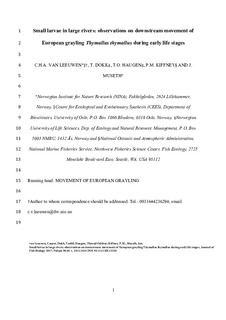Small larvae in large rivers: observations on downstream movement of European grayling Thymallus thymallus during early life stages
Journal article, Peer reviewed
Accepted version

Åpne
Permanent lenke
http://hdl.handle.net/11250/2475790Utgivelsesdato
2017Metadata
Vis full innførselSamlinger
- Publikasjoner fra CRIStin - NINA [2364]
- Scientific publications [1392]
Sammendrag
Behaviour of early life stages of the salmonid European grayling Thymallus thymallus was investigated by assessing the timing of larval downstream movement from spawning areas, the depth at which larvae moved and the distribution of juvenile fish during summer in two large connected river systems in Norway. Trapping of larvae moving downstream and electroshing surveys revealed that T. thymallus larvae emerging from the spawning gravel moved downstream predominantly during the night, despite light levels sufficient for orientation in the high-latitude study area. Larvae moved in the water mostly at the bottom layer close to the substratum, while drifting debris was caught in all layers of the water column. Few young-of-the-year still resided close to the spawning areas in autumn, suggesting large-scale movement (several km). Together, these observations show that there may be a deliberate, active component to downstream movement of T. thymallus during early life stages. This research signies the importance of longitudinal connectivity for T. thymallus in Nordic large river systems. Human alterations of flow regimes and the construction of reservoirs for hydropower may not only affect the movement of adult fish, but may already interfere with active movement behaviour of fish during early life stages. © 2017 The Fisheries Society of the British Isles Key words: behaviour; connectivity; drifting larvae; large river systems; salmonids; spatial distribution.